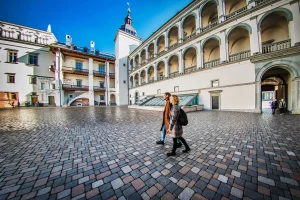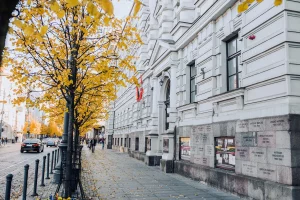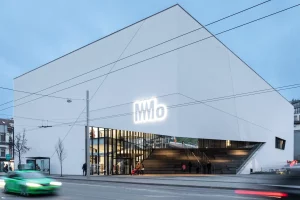Most Loved Places
Look no further. This is the easiest way to discover the best places in Vilnius. Whatever your interests, we’ve got you covered. Just keep scrolling.
Paupys Market
Foodies, it’s time to visit a garden of delights. Discover a new generation of dining experiences in Vilnius. Take a seat in an indoor urban jungle or dine al fresco with a modern view. Share cuisines of the world with friends and create your own tasting dinner. Chefs offer their best dishes as well as exquisite experiments. Your taste buds are in for a surprise!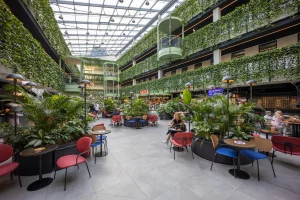
Brief history
Paupys is the newest district in Vilnius; it’s right in the Old Town but surrounded by nature and tranquillity. Modern architecture blends well with the bends of the Vilnelė River and surrounding old trees. The district’s vibrant community of food artisans, promising chefs, creative minds and artists give curious visitors a chance to explore a journey of flavours. Paupys Market is more than just a dining location, it’s a carefully crafted, shared experience.
Užupis
In short
Užupis is the smallest district in Vilnius and is separated from the Old Town by the Vilnelė River. Formerly a troublesome place in the early 1990s, Užupis has grown into a beautiful neighbourhood of artists, intellectuals and entrepreneurs. On 1 April 1997, residents of Užupis decided to somewhat sarcastically declare independence. An independent republic has to havemoney, power, an anthem and constitution, and above all, a free spirit. You will find all of this in Užupis.
Make your way under the Užupis Bridge to have a go on the Swing of Destiny and make sure to say hello to the Mermaid of Užupis while you’re down there.
Brief History
In 1996, a group of students from the Vilnius Academy of Arts founded an art community in a house along the Vilnelė River. The initiative received a lot of support, so in 2002 the artists and the Municipality of Vilnius agreed to establish the Užupis Art Incubator together. This place is famous for its open-air sculptures and installations, which are constantly changing. Come get inspired, laugh and step outside of your comfort zone.
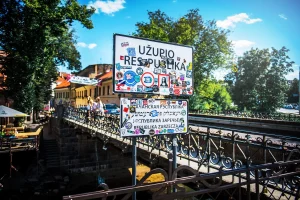
Legend has it that the Dalai Lama suggested placing the Angel of Užupis in its current place on one of
his visits to Vilnius. But the truth is also very beautiful – residents of Užupis were looking for a place to perpetuate the guardian angel of Užupis, Zenonas Šteinis, an artist and active member of the community. This helped him transform the once calm dis
trict into the vibrant Užupis we know today.
Address: Užupis, Vilnius Google Maps
The Gediminas’ Tower
In short
The symbol of Vilnius is visible from many spots in the Old Town and is portrayed in numerous works of art. It is one of the best places to see the magnificent panoramas of Vilnius. Climb Gediminas’ Hill and admire the sunset or go up even higher to the top of the Gediminas Tower for more spectacular views. The red roofs of Vilnius, the church towers, and the narrow streets of the Medieval Old Town are a stunning sight. The tower houses a historic exhibition displaying reconstruction models of the castles of Vilnius, an armament, and iconographic material of old Vilnius.
Gediminas Castle Tower is the most frequently visited branch of the National Museum of Lithuania. Its exhibition invites visitors to learn about the history of Vilnius as the centre of the Grand Duchy of Lithuania, and also to take in the most spectacular panoramic view of the city.
As the visitor climbs up the narrow steps of the tower they will discover several levels of exhibits presenting the development of the Vilnius Castle territory, as well as exhibits of Baltic jewellery and important military artefacts.
The second floor contains the interactive exhibition “Visual timeline: a look through the Windows of Gediminas Tower”, which invites visitors to experience an attack by Crusaders; they can also see what Renaissance Vilnius looked like and compare this image with a panorama of the Upper and Lower castles from 1785, a time when these buildings had already lost their political importance. This journey is an opportunity to experience the changes the city has gone through from the 14th to the 21st centuries – by both looking through the tower windows, then at the tower itself.
On the third floor visitors can experience what it meant to stand in the Baltic Way – one of the most memorable of the big anti-Soviet demonstrations, when, in August 1989, close to 2 millions people linked hands from Vilnius to Tallinn.
From the Tower’s observation square a panorama of Vilnius opens up and it seems as though one can hold the city in one’s hand. And the fluttering national flag reminds us that Gediminas Tower is a symbol not only of Vilnius, but of Lithuania as a whole.
Brief History
Gediminas’ Castle Tower is the remaining fortification tower of the Upper Castle. Legend has it that the Grand Duke Gediminas dreamt of an Iron Wolf howling at the top of this hill, which he took as a prophecy of the great city th
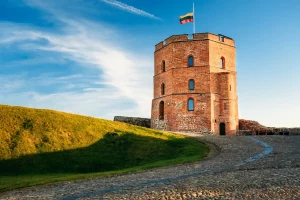 at would one day stand in this place. The hill is where he eventually built a wooden castle.
at would one day stand in this place. The hill is where he eventually built a wooden castle.
Grand Duke Vytautas completed the city’s first brick castle in 1409. Gediminas’ Tower has changed purposes since then, including being used as the city’s first telegraph building in 1838. The Lithuanian flag was first flown at the top of thetower a cen
tury ago. The Vilnius Castle Museum was opened in 1960, and in 1968 it became a subdivision of the Lithuanian National Museum.
Glass Quarter
In short
The Glass Quarter community was formed in October 2018 in the area of Stiklių, M. Antokolskio, Gaono and Žydų streets. Its purpose is to organise cultural routes, tell hidden stories about Vilnius Old Town, establish traditions, improve infrastructure, and attract investors and individuals interested in Old Town culture.
Brief history
The 600-year-old square that once occupied most of the present Old Town was a Jewish neighbourhood of goldsmiths, glassblowers, artisans and financiers. The Goldsmiths Guild was founded there in 1495, followed
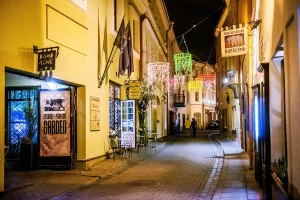
by the first glass manufactory of the Grand Duchy of Lithuania in 1547. This historic community was na
med the Glass Quarter in 2018, recalling the times when there were as many as three Stiklo streets: Stiklo 1, Stiklo 2 and Stiklo 3. As if hidden among the bigger streets of the city, the quarter is still surrounded by jewellers, local artists, artisan shops and workshops, cosy restaurants, the headquarters of the chamber orchestra, art galleries, and
Stikliai Hotel, one of the city’s oldest.
Kazys Varnelis House-Museum
The Vilnius University
In short
One of the oldest universities in the world, Vilnius University, has 12 faculties and around 23,000 students. The Old Campus houses the University administration and 3 faculties – History, Philology, and Philosophy. There is also a library which was founded in 1570. It contains more than 5 million prints and ancient manuscripts. Among them is one of two copies of the first Lithuanian book known to exist – the original Catechism of Martynas Mažvydas.
Brief History
Vilnius University was founded at a time when the Reformation movement was spreading in Lithuania and Jesuit monks were invited to fight the Reformation. The monks of the Jesuit Order quickly took education into their own hands. And founded a college in 1569 before establishing Vilnius University in 1579.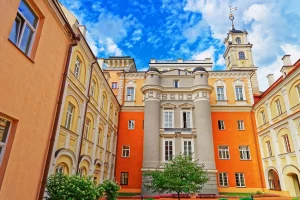
The Vilnius University complex took form over several centuries and therefore consists of Gothic, Renaissance, Baroque and Classicist buildings. The architecture of the medieval palace contrasts with the cheerful student atmosphere. Thirteen patios, arcades and galleries complement the complex. The courtyards are named after prominent university students and professors; memorial plaques have been erected in the Grand Courtyard to commemorate them.
The Palace of the Grand Dukes of Lithuania
Museum of Occupations and Freedom Fights
Toy Museum
In short
The first Lithuanian Toy Museum, located in Vilnius’ old town, not far from Cathedral, in B. Radvilaitė st. 7/2, is divided into an archaeological space, containing the oldest toys, the ethnographical space, showcasing 19th-20th century toys, while the third space is introducing toys of today. The collection contains both original and copies. The copies especially deserve a special attention as in the exhibition they will allow to carry out the principle idea of the museum which is to touch–take–learn about the exhibits.
Brief History
The Toy Museum is the first family-oriented educational centre in Lithuania dedicated to the heritage of toys and games.
The Toy Museum exhibit space amounts to 150 sq. m. The museum is visited by over 18,000 visitors per year. The museum has three thematic exhibitions: “The Oldest Lithuanian Toys”, “Journey to the Stone Age” and “Memories of the 20th Century”.
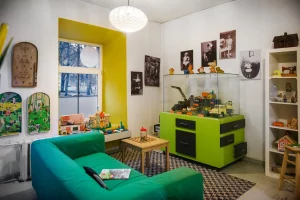 The public enterprise Toy Museum was established on March 8, 2010 by archaeologist Povilas Blaževičius and his wife Indrė Jovaišaitė-Blaževičienė. The basis of the initiative was Blaževičius’ dissertation “Toys and Games in Lithuania in the 13th-17th Centuries Based on Archaeological Data”. With the approval of the Vilnius City Council, the museum was opened to the public on December 7, 2012.
The public enterprise Toy Museum was established on March 8, 2010 by archaeologist Povilas Blaževičius and his wife Indrė Jovaišaitė-Blaževičienė. The basis of the initiative was Blaževičius’ dissertation “Toys and Games in Lithuania in the 13th-17th Centuries Based on Archaeological Data”. With the approval of the Vilnius City Council, the museum was opened to the public on December 7, 2012.
The building, which houses the museum, was built around the end of the 17th century, and in the 18th century, it housed the residential buildings and outbuildings of canon Antonovich, as well as a brewery. In 1785, they were bought by canon Rodkevičius, and his family owned the building for about 150 years.
MO Museum
Open Gallery
In short
This unique open-air art gallery is a long-term interdisciplinary project and cultural initiative that presents urban culture in an original way and creatively revitalizes the post-industrial New Town. The initiative seeks to present creative alternatives to traditional art forms, such as paintings on factory walls, installations, sculptures, performances, and non-commercial film screenings. At the same time, Open Gallery encourages Lithuanian and foreign artists of different fields to cooperate with each other.
Brief History
Open Gallery is a project belonging to the art factory Loftas. It’s a long-term interdisciplinary project that brings
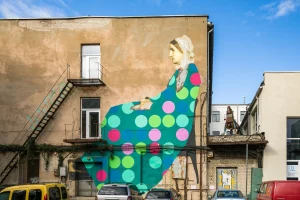 together talented Lithuanian and foreign artists for creative work and has developed into an international open-air gallery of street art, sculptures and installations. The gallery is located in the courtyard of the former Elfa factory, where the art factory Loftas is now l
together talented Lithuanian and foreign artists for creative work and has developed into an international open-air gallery of street art, sculptures and installations. The gallery is located in the courtyard of the former Elfa factory, where the art factory Loftas is now l
ocated.
One of Open Gallery’s main goals is to revive the former abandoned territories of the city for new life, thus revealing the unprecedented face of the Lithuanian capital to residents and guests of the city. The gallery is free of charge and open to anyone at any time.
The Cathedral Basilica of St. Stanislaus and St. Ladislaus
In short
This shrine is a symbol of Lithuanian baptism. The Cathedral Basilica of St. Stanislaus and St. Ladislaus is built in the very centre of the city on the site of a former pagan temple and next to Vilnius’ defensive castle.
Lithuania’s patron saint St. Casimir rests in the Cathedral Basilica. Jurgis Matulaitis served as the basilica’s bishop from 1918 to 1925. On 4 September 1993, the Holy Father John Paul II began his historic apostolic journey through Lithuania at the Vilnius Cathedral.
Visits to the Cathedral catacombs should be directed to the Church Heritage Museum (www.bpmuziejus.lt)
Brief History
Vilnius Cathedral was rebuilt several times as a result of frequent fires, wars and unstable soil under its foundation. Due to the building’s importance, many prominent foreign and local architects and artists led the reconstruction projects. The building currently reflects the Classicist style (architect Laurynas Stuoka-Gucevičius), but its walls have traces of Gothic, Renaissance and Baroque.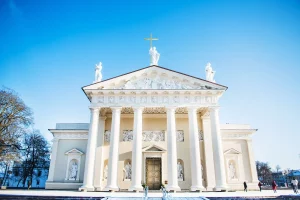
A 57-metre tall bell tower stands right by the cathedral and is one of the symbols of Vilnius.
The history of the bell tower dates back to the middle of the 13th century: the defensive tower that stood here in the 16th century became a bell tower and got its current appearance at the beginning of the 19th century. The city’s oldest clock at the top of the tower chimes its bells to invite people to mass. An exhibition inside the tower recounts its history and offers visitors a spectacular view of the Old Town.
The Hill of Three Crosses
In short
Standing atop the hill that bears its name, the Three Crosses memorial consists of three white reinforced concrete crosses that are visible from afar. Climb the hill and you’ll see vast panoramas of Vilnius Old Town. Plus, the Bernardine Garden and Vilnele River are right at the foot of the hill. This 12-metre tall monument has become a symbol of national identity, but the crosses themselves are often illuminated in different colours to commemorate special events for Lithuania and the world. So whenever you can see the monument while walking around the city after dark, take a look to see if it’s lit up in special colours.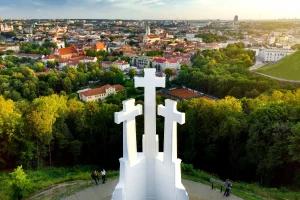
Brief History
A wooden castle was built on the hill in the 12th and 13th centuries, and a settlement was later established in its place. The hill got its name after Franciscans died as martyrs when pagans tied them to crosses and threw them down the hill. The three crosses were erected to commemorate this event. The current monument was created by architect and sculptor A. Vivulskis in 1916 and rebuilt in 1988.
Gediminas’ Hill
In short
Standing 48-metres tall, the hill is one of the highest points in Vilnius Old Town, making it a perfect spot to get a 360° view of the city. On one side you can see the red rooftops of the Old Town, and on the other the modern city with glass skyscrapers and the Neris River flowing. This is also your chance to see the Vilnius Cathedral from above. Visitors can either walk up the hill or take the funicular.
Brief History
Gediminas’ Hill is an anthropogenically-modified slope of erosive origin, transformed into a fortified castle. Legend has it that Grand Duke Gediminas dreamt of a howling Iron Wolf on the hilltop, whic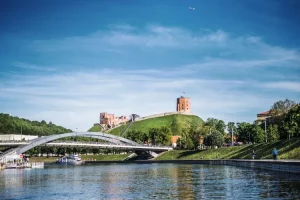 h he took as a prophecy of the great city that would one day stand in this place. The hill is where he built a wooden castle in the 14th century.
h he took as a prophecy of the great city that would one day stand in this place. The hill is where he built a wooden castle in the 14th century.
In 1989, Gediminas’ Hill also served as one of the starting points of the Baltic Way, a historic human chain running from Lithuania to Estonia in protest of Soviet occupation. The city installed a funicular on the hill in 2003, making it easily accessible for those with reduced mobility and families with small children. In 2019, remains of the leaders and participants of the 1863-1864 rebellion were found on the hillside.
Trakai Castle
Important information for Museum’ Visitors
*We inform You that renovation work is underway in the Dukes Palace of the castle.
In short
The castle is famous for its gothic architecture and its special location – it stands on an island on Lake Galve, one of the deepest lakes in Lithuania. The view of the historic structure is straight out of a fairy tale. You can reach the castle by crossing the long wooden bridge. In the winter the lake freezes over and becomes a natural skating rink. You can also take in a special view of the castle from a yacht.
Visit the museum inside the castle to explore the exhibitions of the Grand Dukes of Lithuania, va
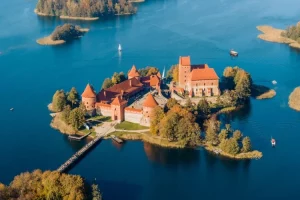 rious archaeological findings and artefacts, as well as a collection of art. In the summer there are medieval festivals as well as va
rious archaeological findings and artefacts, as well as a collection of art. In the summer there are medieval festivals as well as va
rious events and concerts in the castle’s courtyard.
Brief History
The castle was built in the 14th century and served as a residence for the Grand Dukes of Lithuania. However, the structure fell into disarray in the 17th century and was only rebuilt in 1951. In 1962, the castle became a part of the Trakai History Museum.


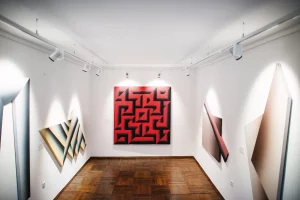 viewed witha guide, which requires advance booking. The extended tour offers the opportunity not only to become acquainted
viewed witha guide, which requires advance booking. The extended tour offers the opportunity not only to become acquainted